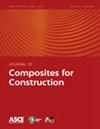NSM GFRP Strengthening of Reinforced Concrete Beams after Exposure to Fire: Experiments and Theoretical Model
IF 2.9
2区 工程技术
Q2 ENGINEERING, CIVIL
引用次数: 0
Abstract
The effectiveness of near-surface mounted glass fiber–reinforced polymer (NSM GFRP) retrofitting of reinforced concrete (RC) beams after exposure to fire is investigated in this study both experimentally and analytically. Experiments were performed on nine RC beams: one beam was not exposed to fire (control specimen) and eight beams were divided into two groups exposed to fire for 30 and 60 min. In each group, one beam was not retrofitted, whereas the other three beams were retrofitted using NSM GFRP. After retrofitting, all beams were loaded until failure. The experimental results confirmed that the retrofitting technique effectively recovered the strengths of postfire RC beams. The failure mode of the GFRP retrofitted beams was the peeling-off of concrete cover, whereas that of the control and unretrofitted postfire beams was flexural failure via the yielding of tension steel. The NSM GFRP retrofitting fully recovered or significantly increased the yield and ultimate strengths of postfire RC beams by up to 39%. The yield deflection capacity of the NSM GFRP retrofitted postfire beams was much higher than that of the control beam; however, the ultimate deflection capacity of these beams significantly decreased. Consequently, the GFRP retrofitted postfire beams were of low ductility because of the peeling-off of the concrete cover. NSM GFRP retrofitting slightly improved but did not completely recover the yield stiffness reduced by fire, whereas it increased the plastic stiffness significantly by up to threefold. An analytical model for estimating the yield moment of postfire RC beams without/with NSM GFRP retrofitting was proposed, considering the very limited information, for example, fire duration obtained from actual fire events. The practicality and reasonable accuracy of the proposed model render it beneficial for structural engineers.NSM GFRP对火灾后钢筋混凝土梁的加固:实验与理论模型
本文从实验和分析两方面研究了近表面安装玻璃纤维增强聚合物(NSM GFRP)对火灾后钢筋混凝土(RC)梁的加固效果。实验在9根RC梁上进行:1根梁未暴露于火中(对照试件),8根梁分为两组,分别暴露于火中30和60分钟。每组中,1根梁未进行改造,而其他3根梁则使用NSM GFRP进行改造。改造后,所有梁都被加载,直到失效。试验结果表明,加固技术能有效地恢复火灾后RC梁的强度。GFRP加固梁的破坏模式为混凝土覆盖层的剥离,而对照和未加固的火后梁的破坏模式为受拉钢屈服的弯曲破坏。NSM GFRP加固完全恢复或显著提高了火灾后RC梁的屈服和极限强度,最高可达39%。NSM玻璃钢加固火后梁的屈服挠曲能力远高于对照梁;然而,这些梁的极限挠度能力明显降低。因此,由于混凝土覆盖层的剥离,GFRP加固的火灾后梁的延展性较低。NSM GFRP改造略有改善,但不能完全恢复火灾降低的屈服刚度,而塑性刚度则显著提高了三倍。考虑到从实际火灾事件中获得的火灾持续时间等信息非常有限,提出了不加/加NSM玻璃钢加固的RC梁火灾后屈服矩的分析模型。该模型的实用性和合理的精度对结构工程师有一定的参考价值。
本文章由计算机程序翻译,如有差异,请以英文原文为准。
求助全文
约1分钟内获得全文
求助全文
来源期刊

Journal of Composites for Construction
工程技术-材料科学:复合
CiteScore
7.40
自引率
8.70%
发文量
102
审稿时长
3 months
期刊介绍:
The Journal of Composites for Construction publishes original research papers, review papers, and case studies dealing with the use of fiber-reinforced composite materials in construction. Of special interest to the Journal are papers that bridge the gap between research in the mechanics and manufacturing science of composite materials and the analysis and design of large civil engineering structural systems and their construction processes. The Journal publishes papers about composite materials consisting of continuous synthetic fibers and matrices for use in civil engineering structures and subjected to the loadings and environments of the infrastructure. The Journal publishes papers about composite materials in stand-alone forms (e.g., structural shapes) or used in conjunction with traditional construction materials such as concrete, masonry, metals and timber, either as reinforcing members or in hybrid systems, for both new construction and for repair and rehabilitation of existing structures. The Journal also publishes papers about codes and standards related to fiber-reinforced composites for construction.
 求助内容:
求助内容: 应助结果提醒方式:
应助结果提醒方式:


